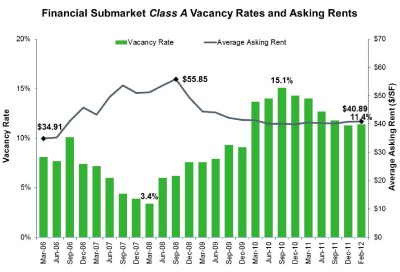Despite the influx of residential units (in both new buildings and conversions), the financial district submarket remains quite relevant regarding its office product.
Though many buildings along Wall Street have found new uses, most of Broadway, State Street and Water Street have held their ground with their buildings remaining as originally intended—office space.

That said, the employee mix has changed somewhat from the mid- to the late-20th century, when it was almost exclusively financial services. Today, one is just as likely to find a tech or media office. Of course, lower Manhattan has seen a tech boom before, during the late 1990s.
This go-round, though, the growth is more media-based and, unlike last time, the firms generally have an actual product. Those types of tenants have certainly helped keep the vacancy rate to a manageable figure recently, with the February Class A number coming in at 11.4 percent. That is a smidge higher than the 11.3 percent at year-end 2011 but well off the downturn peak of 15.8 percent in July 2010.
Of course, the market has been better as recently as March 2008, when the vacancy rate slid to 3.4 percent. Most recently, there was a large block added to availability—142,000 square feet at 40 Wall Street. And on deck, there is another—645,000 square feet at 55 Water Street (now being marketed but not available until at least mid-2013). There are also others including 85 Broad Street and 1 New York Plaza.
But with the pricing sharply below that of Midtown Class A availability ($40.89 versus $71.28 per square foot) and with the increased tenancy of media and tech (which are particularly in love with mixed-use neighborhoods and less expensive space), expect the financial submarket to remain relevant well into the future.
—Robert Sammons, Cassidy Turley


